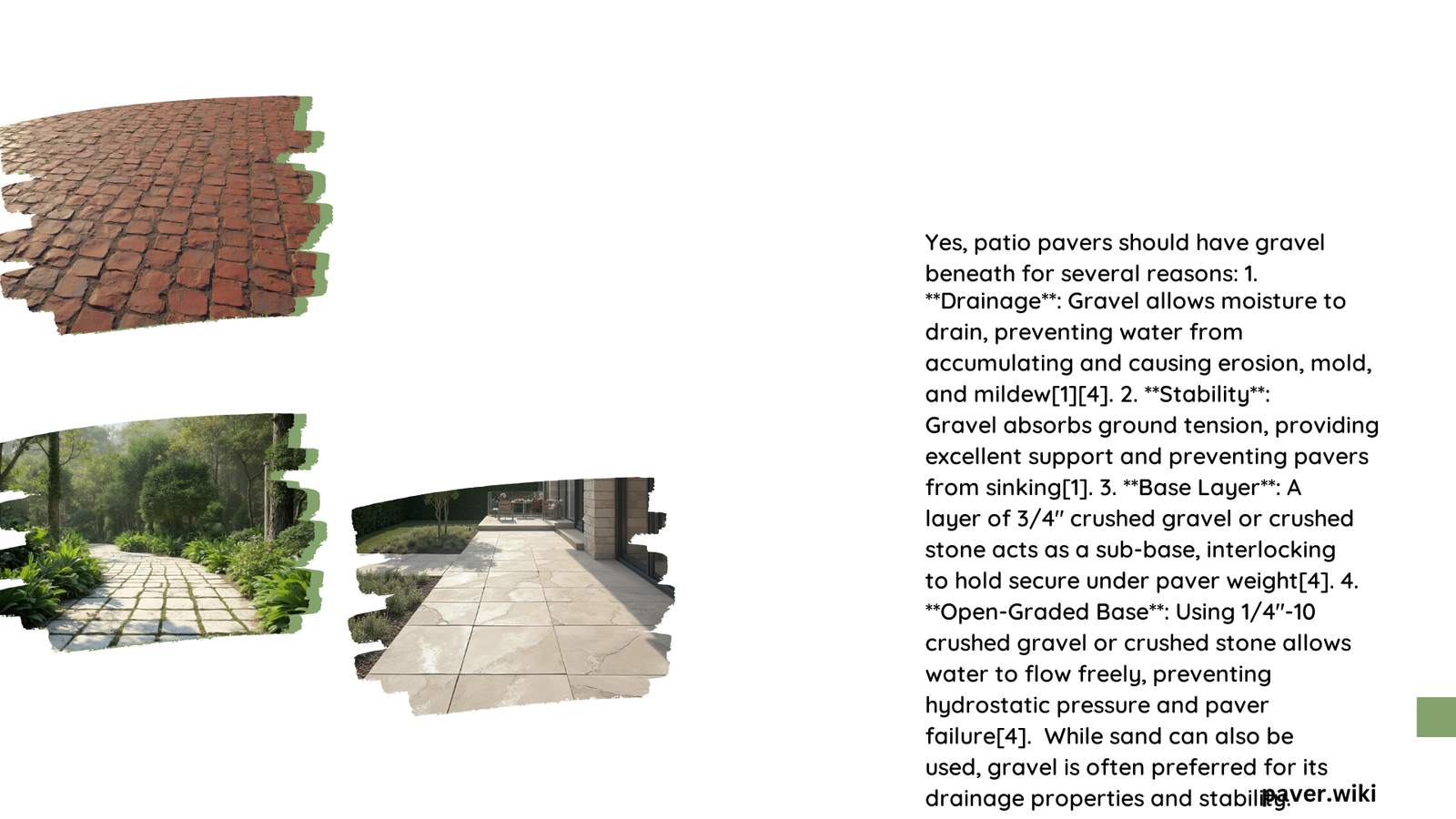Patio pavers should indeed have gravel beneath them. A gravel base provides crucial drainage, stability, and longevity for paver installations. It prevents water accumulation, reduces paver movement, and helps distribute weight evenly. This guide explores the importance of gravel beneath patio pavers, installation requirements, alternatives, and potential challenges to help you make informed decisions for your patio project.
Why Should Patio Pavers Have Gravel Beneath?
Gravel beneath patio pavers serves several essential functions:
- Drainage: Prevents water accumulation and potential damage
- Stability: Provides a firm foundation, reducing paver movement
- Longevity: Extends the life of your patio by preventing settling and shifting
- Weed prevention: Helps inhibit weed growth between pavers
What Are the Benefits of Using Gravel Under Pavers?
Using gravel as a base for patio pavers offers numerous advantages:
- Improved drainage: The angular shape of gravel particles allows water to drain away effectively, preventing moisture-related issues like erosion, mold, and mildew.
- Enhanced stability: A well-compacted gravel base reduces paver movement, especially in areas with heavy foot traffic or soil shifting.
- Increased longevity: A proper gravel base can significantly extend the life of your patio by withstanding everyday use and environmental factors.
- Weed suppression: While not its primary function, a compacted gravel base can help prevent weeds from growing up through the pavers.
How Does Gravel Affect Paver Installation Longevity?
Gravel plays a crucial role in the longevity of paver installations:
- A 4-6 inch deep gravel base can effectively support pedestrian areas like patios and walkways.
- In regions with freeze-thaw cycles, a deeper base (6-8 inches for patios and up to 12 inches for driveways) is recommended.
- The stability provided by a gravel base can prevent common issues like shifting and sinking, particularly in areas with clay soil and cold winters.
What Are the Gravel Requirements for Patio Paver Installation?

Proper gravel selection and installation are crucial for a successful patio paver project. Here are the key requirements:
Which Gravel Types Are Recommended?
- Crushed Stone: Commonly used for paver bases, especially size #57 (3/4 to 1 inch in diameter).
- Processed Road Base: A mixture of fine stone dust and gravel, ideal for driveways and walkways due to its load-bearing properties.
What Is the Necessary Gradation for Gravel Base?
The gravel base should consist of a mix of differently sized stone particles to create a compact and stable surface. For example:
- Dense-graded aggregate like Granular A (3/4 minus)
- Mixture of crushed gravel or rock and stone dust
This combination ensures good compaction and cohesivity.
What Are the Best Compaction Techniques?
To achieve optimal stability:
- Compact the gravel base in lifts according to the compactor’s capability.
- Typically, compact in 2-3 inch lifts until reaching the desired depth.
- Ensure each layer is properly compacted before adding the next.
What Is the Optimal Gravel Depth for Different Applications?
| Application | Recommended Depth |
|---|---|
| Pedestrian areas (patios, walkways) | 4-6 inches |
| Areas with freeze-thaw cycles (patios) | 6-8 inches |
| Driveways in freeze-thaw regions | Up to 12 inches |
Are There Alternatives to Gravel Base for Patio Pavers?
While gravel is the most common and recommended base material, there are alternatives:
Can Sand Be Used Instead of Gravel?
Sand can be used as a bedding layer above a gravel base but is not recommended as the primary base material:
- Pros:
- Provides good drainage
- Easy to work with
- Cons:
- Lacks long-term support
- Not suitable for high-traffic areas
Is Concrete a Viable Alternative?
Pavers can be laid directly onto existing concrete or set onto wet concrete:
- Pros:
- Provides a long-lasting patio
- Minimal movement or sinking
- Cons:
- Less flexible than a gravel base
- Requires more maintenance
- More expensive than gravel
What About Plastic Grid Systems?
Plastic grid systems are an eco-friendly alternative:
- Pros:
- Provide a stable base
- Allow for good drainage
- Suitable for areas with poor soil conditions
- Cons:
- Generally more expensive than traditional gravel bases
What Are the Challenges in Using Gravel Beneath Patio Pavers?
While gravel is an excellent base material, there are potential challenges to consider:
How Can Settling Issues Be Prevented?
Settling can occur due to improper compaction. To prevent this:
- Ensure the gravel base is compacted in lifts
- Use appropriate compaction equipment
- Achieve the desired density before laying pavers
What Drainage Problems Might Occur?
Poor drainage can result from:
- Improper grading of the gravel base
- Insufficient compaction
Solution: Use open-graded bases with clean or clear stones to ensure proper drainage.
What Maintenance Is Required?
Regular maintenance is necessary to ensure the longevity of the pavers:
- Brush paver sand into the joints periodically
- Ensure the base remains compacted over time
- Address any settling or shifting promptly
By understanding these challenges and implementing proper installation techniques, you can create a durable and long-lasting patio paver surface with a gravel base.
